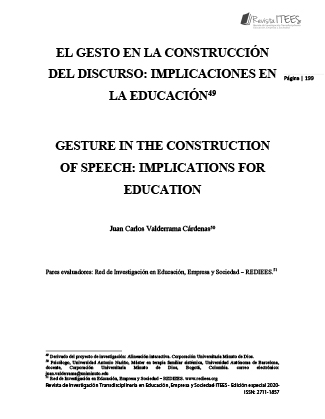IX. GESTURE IN THE CONSTRUCTION OF SPEECH: IMPLICATIONS FOR EDUCATION
##plugins.themes.bootstrap3.article.main##
Abstract
The present study is based on the communicational resources in the teacher-student
relationship, especially in the construction of the spoken discourse in the interaction,
considering practices that can favor mutual understanding; it was based on the idea that the
hands reflect the content of the thought. We tried to know the implications of the "manipulation" of the hand gestures in the speech of 20 university students. The participants
were presented with a scene from a cartoon and were asked to retell the story to another
participant who does not know the scene. The situation has two moments: a) free story and
b) story where the use of gestures is stimulated. All the applications were made with a front
camera and the videos were coded with ELAN; the marking criterion was that the gesture
was co-expressive to the speech and that the trajectory was well defined. It was found that in
the free situation the narration is shorter and of less complexity; in the situation of favoring
gestures a greater number of gestural phrases and words are used. In conclusion, it is argued
that communication in education is favored if verbal and non-verbal resources are used,
which has implications for the teacher and the student in the illustration-transmission of ideas
and concepts.
Download Statistics
##plugins.themes.bootstrap3.article.details##
: gesture, communication, thinking, speech, education, learning, cognition.
Federmeier, The psychology of learning and motivation (pp. 107-133). Cambridge:
Elsevier.
Cook, S. W., & Tanenhaus, M. (2009). Embodied communication: Speakers’ gestures affect
listeners’ actions. Cognition, 113(1), 98-104. doi:
https://doi.org/10.1016/j.cognition.2009.06.006
Cravotta, A., Busà, M. G., & Prieto, P. (2018). Restraining and encouraging the use of hand
gestures: Effects on speech. 206-210. Paper presented at the Proceedings of the
International Conference on Speech Prosody. doi:10.21437/SpeechProsody.2018-42
Cravotta, A., Busà, M. G., & Prieto, P. (2019). Effects of encouraging the use of gestures on
speech. Journal of Speech, Language, and Hearing Research, 62(9), 3204-3219. doi:
https://doi.org/10.1044/2019_JSLHR-S-18-0493
Dargue, N., & Sweller, N. (2020). Two hands and a tale: When gestures benefit adult
narrative comprehension. Learning and Instruction, 68. doi:
https://doi.org/10.1016/j.learninstruc.2020.101331
ELAN. (2019). Nijmegen: Max Planck Institute for Psycholinguistics, The Language
Archive. https://archive.mpi.nl/tla/elan
Follari, J. E. (2015). El código de transcripción de Gail Jefferson: adaptación para las ciencias
sociales. Quaderns de Psicologia, 17(1), 39-62. doi:
https://doi.org/10.5565/rev/qpsicologia.1252
Kendon, A. (2017). Pragmatic functions of gestures: Some observations on the history of
their study and their nature. Gesture, 16(2), 157-175. doi:
https://doi.org/10.1075/gest.16.2.01ken
Lin, Y. L. (2017). Co-occurrence of speech and gestures: A multimodal corpus linguistic
approach to intercultural interaction. Journal of Pragmatics, 117, 155-167. doi:
https://doi.org/10.1016/j.pragma.2017.06.014
McNeill, D. (1992). Hand and mind: What gestures reveal about thought. Chicago:
University of Chicago press.
McNeill, D. (2005). Hand and Thought. Chicago: University of Chicago Press.
McNeill, D. (2016). Why We Gesture: The surprising role of hand movements in
communication. Chicago: Cambridge University Press.
McNeill, D., & Duncan, S. (2000). Growth points in thinking-for-speaking. In D. McNeill,
Language and gesture (pp. 141-161). Cambridge: Cambridge University Press.
Mondada, L. (2016). Challenges of multimodality: Language and the body in social
interaction. Journal of sociolinguistics, 20(3), 336-366. doi:
https://doi.org/10.1111/josl.1_12177
Parrill, F., McKim, A., & Grogan, K. (2019). Gesturing standard deviation: Gestures
undergraduate students use in describing their concepts of standard deviation. The
Journal of Mathematical Behavior, 53, 1-12. doi:
https://doi.org/10.1016/j.jmathb.2018.05.003
Valderrama Cárdenas, J. C. (2019). Por qué y para qué estudiar los gestos. In J. A. Bernate,
M. J. Betancourt Jiménez, J. A. Carrillo Villamizar, I. P. Fonseca Franco, M. F. García
Celis, W. S. Ortiz Navarrete, . . . Urrea Roa, Perspectiva de Transformación Social
en la Educación y la Empresa (pp. 73-103). Bucaramanga: Editorial Eidec.
Vigotsky, L. (1986). Pensamiento y lenguaje. Barcelona: Paidos





